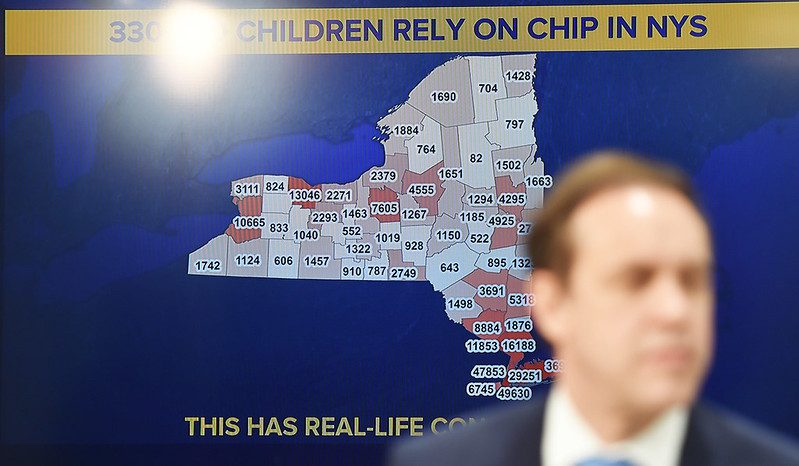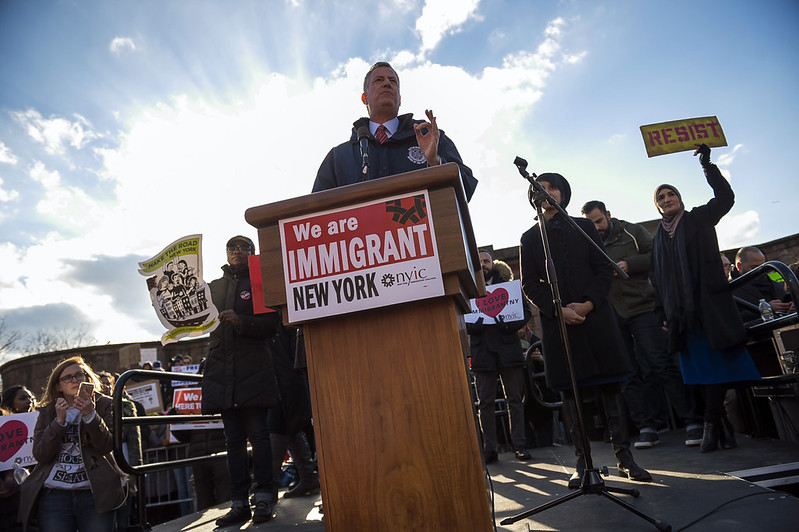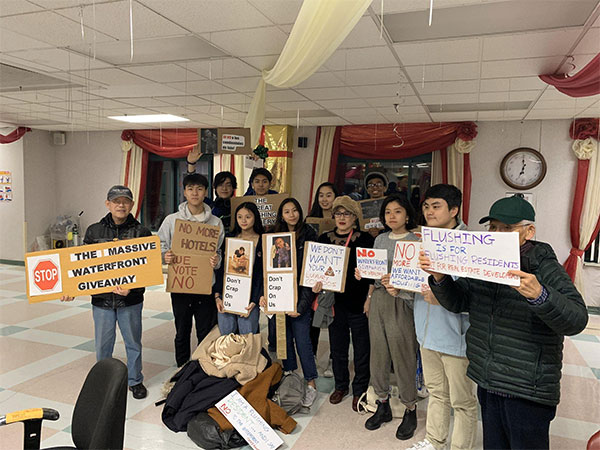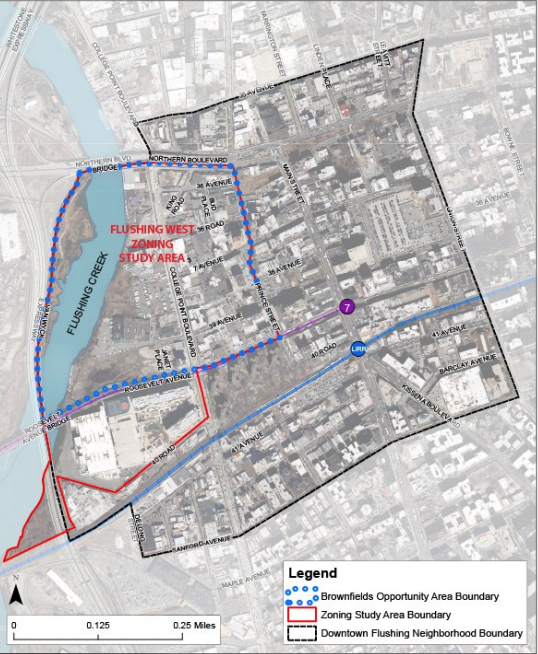The Medicaid Solution No One Is Talking About

Another way of thinking about the state's Medicaid mess (photo by Kevin Coughlin/Governor's Office)
With Medicaid being blamed for the roughly $6 billion deficit our state is facing, most politicians see only two possible solutions: raise taxes or cut services.
Yet a far better third option exists: get rid of the for-profit insurers getting rich off our tax dollars, and recoup those funds for actual patient services.
Payments to private insurers are the silent bloat in New York's Medicaid budget, driving up our cost more than any other state in the nation.
Medicaid is a federal program that provides health insurance to people who can’t afford it. In New York, that’s one-third of us -- one out of every three neighbors, children, workers, seniors, and taxpayers.
Federal funds from taxpayers pay half and in most places across the country, the state pays the other half. But here in New York, Albany sends part of the bill to county taxpayers, to raise through regressive property taxes.
The feds let each state decide how to deliver Medicaid. And while there’s a big debate over single-payer universal healthcare (which I support), ignored in that debate is that Medicaid itself is not single-payer in New York.
Instead, we send our tax dollars to for-profit “Managed Care Organizations” (MCOs), like United Healthcare and WellCare.
Huge chunks of New York’s whopping $70 billion Medicaid budget flow to Big Insurance MCOs. The sicker people are, the more Big Insurance can bill.
The point of being in business is to make a profit, but the purpose of a taxpayer-funded program like Medicaid is supposed to be health care. Instead of blaming corporations for making a profit, I blame a government system that hands it over without question.
To top it off, these payments aren’t efficient. New York spends more per enrollee than 42 other states. When we hear that, some might think that means patients in New York get more out of Medicaid than patients in other states. But that’s not true.
Of the 38 states that use MCOs for Medicaid, New York is among the most expensive. In other words, not only is New York paying for-profit corporations with Medicaid funds, we are paying those corporations more than most states. New York State Comptroller Tom DiNapoli’s audit of our Medicaid budget just found almost $800 million in fat that can be trimmed off tax dollars funneled through Medicaid to Big Insurance and Big Pharma. With a projected 2020 state budget deficit of around $6 billion, that’s a good start - but as long as profit is the motive, costs will always go up.
The current system is bolstered by the steady stream of campaign contributions by those same private insurers to Albany politicians. In 2018, UnitedHealthcare PAC donated $40,000 to Democratic Governor Andrew Cuomo and $44,000 to the Republican Senate Campaign Committee. That’s just the tip of the iceberg.
Usually, politicians in Albany keep us bickering among ourselves about whether to raise taxes or cut services, while they soak up these campaign contributions from Big Insurance.
This time, let’s demand Albany doesn’t raise our taxes to pad corporate profits and doesn’t cut services to New Yorkers’ needed health care. Let’s cut costs by axing corporate profit off Medicaid. Let’s make Medicaid single-payer, and get rid of Medicaid for Profit.
***
Leslie Danks Burke is a 2020 Democratic candidate for State Senate in New York's five-county Southern Tier and Finger Lakes 58th Senate District. On Twitter @LDanksBurke.
***
Have an op-ed idea or submission for Gotham Gazette? Email This email address is being protected from spambots. You need JavaScript enabled to view it.
No Matter Trump’s Agenda, Refugees Remain Welcome in New York City

(photo: Ed Reed/Mayoral Photography Office)
Our nation has long been a beacon of hope for those fleeing their home country due to violence and persecution based on their race, nationality, religion, political beliefs, or membership in a social group. With resettlement as a refugee’s last option for safety, we have welcomed them and supported their successful integration in the United States for nearly 40 years with the establishment of the Refugee Resettlement Program.
Under the Trump administration, however, this country’s proud tradition of welcoming refugees and recognizing the contributions and impact of hardworking immigrants is under threat.
On September 26, 2019, President Trump signed Executive Order 13888—an unprecedented move to allow states and localities to block refugees from being resettled in their communities. His administration also capped total refugee admissions to a historic low of 18,000 at a time when the number of refugees and displaced people worldwide is at the highest point since World War II.
And as we’ve just honored Holocaust Remembrance Day this week, we must not forget the dark times out of which these policies and programs were created. Our nation turned a blind eye as millions of Jews were murdered during the Holocaust, including the hundreds of thousands that applied to immigrate to our country but were turned away due to the strict immigration laws and quotas that were in place at that time.
It was out of this humanitarian crisis that our country vowed not only to never forget, but never go back. Congress passed the first piece of refugee legislation in 1948, which would eventually become the Refugee Resettlement Program as we know it today. A profound moment of moral leadership and recognition that to sit idly by while the “victims of war and oppression” look to us for refuge is to hold “their fate in…our hands.”
Despite the best efforts of the Trump administration to dismantle the refugee program and take us back to those dark times, states and localities – many who share the deeply personal, profound, and real stories of refugees in their communities – have responded with an outpouring of support.
From Phoenix, Arizona, to Burleigh County, North Dakota, to Worthington, Minnesota, jurisdictions from across the nation have affirmed their commitment to resettle refugees in their communities and have recognized that true leadership considers the moral responsibility we hold to care for our fellow human beings who seek refuge from persecution.
New York City not only proudly issued consent to resettle refugees, but the city went a step further and joined a multi-city amicus brief in support of the litigation challenging the president’s order. Mayor de Blasio also joined with leaders across the nation urging the Trump administration to rescind the executive order and return this year’s refugee admissions cap to previous levels. And on January 15 a federal judge blocked the executive order from going into effect for the time being.
The message is loud and clear: refugees are not only welcome, but they are invaluable assets to every community they make home. With refugee workforce participation at 81.8 percent, far more than the 63 percent national average, and with refugees quickly surpassing United States median household income and owning more businesses than any other group—immigrant or otherwise—refugees contribute meaningfully to our economy as earners, taxpayers, and job creators. They enrich our neighborhoods and communities through their cultural contributions, civic participation, and engagement.
It is shameful that the Trump administration continues to turn its back on refugee and immigrant communities. Just this week, the Supreme Court made the deeply troubling decision to allow the Trump administration’s xenophobic Public Charge Rule to go into effect—targeting working immigrant families. While the merits of the case are still being fought in court, millions of families, children, and the elderly are at risk.
May our history guide us in the recognition that from a place of darkness and depravity our country grew small and stained and from there we had no choice but to embrace the light and commit to a better and more just way.
At a time when there are so many efforts to divide us, communities in New York and across the country continue to say, we will never go back to closing doors on those in need, and we will not allow the Trump administration to scare us into silence.
***
Bitta Mostofi is Commissioner of the Mayor’s Office of Immigrant Affairs. On Twitter @bittamostofi of @NYCImmigrants.
***
Have an op-ed idea or submission for Gotham Gazette? Email This email address is being protected from spambots. You need JavaScript enabled to view it.
Special Flushing Waterfront District: A Massive Giveaway?

Flushing Special Waterfront District protestors
Most Flushing community stakeholders, including at least one Community Board 7 member, learned from a December YIMBY article that a massive waterfront rezoning and special district application had been certified by the City Planning Commission, initiating the seven-month Uniform Land Use Review Procedure that could make it a reality.
Eager to learn the details of the proposed rezoning and new development, the January 7 CB 7 land use committee meeting was attended by so many unfamiliar faces such that the committee chair asked everyone for a brief self-introduction.
While Flushing resident and activist Bobby Nathan was among a handful of attendees who expressed their opposition to the Special Flushing Waterfront District rezoning that evening, many others in subsequent meetings joined him. Initially protestors were dismissed for being “rude and inconsiderate,” then five NYPD officers were called to the January 21 meeting due to a group of protesters holding signs stating sentiments such as “We don’t want your -ty luxury condos.”
The Special Flushing Waterfront District proposal would add nine buildings for a total of 13 towers (four buildings provide a base for two towers each) in a 29-acre site bounded by 36th Avenue to the north, College Point Blvd to the east, 40th Road to the south, and the Flushing Creek to the west. All the proposed towers except for two will exceed the FAA height restrictions in the primary approach path to LaGuardia Airport, which is less than two miles away.
These towers would add 3 million square feet in luxury hotels, residential condos, retail, and office space. The addition of 1,725 luxury residential condos represents more than half of the total volume of luxury condos added to the Flushing market in the past decade. To facilitate pedestrian and vehicular circulation, a network of “publicly accessible” private streets and private extensions of existing mapped streets will connect the cluster of mixed-use towers.
The development team’s presentations emphasize the introduction of an urban scale and improvements in the public realm as primary community benefits. However, the architectural renderings underscore the utility of the open space, which largely serves to provide relief from the massive building bases lined with ground-level retail storefronts rather than accommodate passive or active recreational use.
The public realm includes a pedestrian path that will connect the new blocks along the Flushing Creek (which remains polluted by combined sewage and stormwater overflows). The other community benefit is a miniscule 61 units of affordable housing at 80% of Area Median Income (AMI) equal to $85,360 for a family of four, while the median household income in downtown Flushing is closer to $41,000.
Despite the massive scale, complicated and layered environmental matters including the remediation of brownfields and the Flushing Creek, construction in a coastal flood hazard area and hurricane evacuation high-risk zone, and outstanding public safety concerns due to the proposed building heights that potentially obstruct airplane navigation, the Department of City Planning issued a negative declaration on the Environmental Assessment Statement, meaning that the agency found “no significant effect on the quality of the environment.”
The negative declaration eliminates two pre-ULURP opportunities for public review and comment on the socioeconomic, environmental, and neighborhood impacts of this complicated and transformative special district and rezoning application. Because of the negative declaration, Flushing stakeholders were denied an opportunity for a public scoping hearing to comment on topics that should be part of an Environmental Impact Statement, and another opportunity to review and comment on a comprehensive Draft Environmental Impact Statement.
The Department of City Planning explained the negative declaration is merited because the development area is a commercial (C4-2) zone and the proposed new density and uses are as-of-right. Only a small portion of the development site will be rezoned from a manufacturing (M3-1) zone to a mixed manufacturing-residential (M1-2/R7-1) zone.
Department of City Planning’s explanation, however, is deceptively simplistic. Since the development site is comprised of numerous lots, several that are large (in the range of 100,000 square feet) and deep (as they are bounded by College Point Blvd and the waterfront, reaching 582 feet in depth) and varied in topography and grade (downward slope to the Flushing Creek), the as-of-right zoning is “fairly restrictive.” Moreover, the 1998 Waterfront Access Plan applies to the site and requires provision of “a shared public walkway, upland connections to the public walkway, and visual corridors.” Given these significant site constraints, a special district designation is essential for the developer-owners to maximize the commercial (C4-2) zoning bulk and density parameters.
To resolve these challenges, the three property owners formed FRWA LLC to work with the Department of City Planning and a small army of master planners, architects, engineers, and lawyers to divide the 29-acre area into buildable sites that facilitate visual corridors connected by privately owned and managed streets.
In order to maximize the commercial (C4-2) as-of-right buildable floor area, the special district requires a waiver to permit 11 towers to exceed the FAA’s strict height restrictions. Moreover, the special district lowers the parking to a commercial (C4-4) zoning that requires one parking space per 1,000 sq. ft. rather than per 300 sq. ft. in a C4-2.
In contrast to City Planning’s position that the proposed density is as-of-right, a Special Flushing Waterfront District to waive FAA restrictions, modify WAP zoning controls, and stipulate additional state and federal environmental approvals is necessary for FRWA LLC to maximize their C4-2 development rights. In order words, the proposed waterfront district is not truly as-of-right because the development scheme is dependent on numerous waivers and modifications of land use rules.
The planning for the Special Flushing Waterfront District dates back to 2010, when former Queens Borough President Claire Shulman’s Flushing Willets Point Corona Local Development Corporation (FWC LDC) secured a $1.5 million New York State Brownfields Opportunity Areas (BOA) planning grant.
FWC LDC hired ARKF to conduct baseline land use, zoning, and environmental studies of a larger 60-acre study area. In 2014, FWC LDC transferred the remaining $800,000 of the BOA grant to the Department of City Planning to complete these studies and prepare a zoning proposal. During this stage of planning, City Planning dubbed an 11-block portion of the waterfront area (approximately 47 acres) Flushing West, and expanded the scope of the zoning study to include new affordable housing production as part of Mayor de Blasio’s Housing New York plan. Crain’s New York Business reported on this highly unusual arrangement:
“The role of the (FWC LDC) in the planning process and the money it will be paying the department raise questions about who is actually running the show in this part of Queens and how much real estate interests who support the initiative— including members of the development corporation's board—stand to gain.”

Described as “under the radar,” Flushing West joined Brooklyn’s East New York and Jerome Avenue in the Bronx as the first neighborhood rezonings eyed for implementing the mayor’s mandatory inclusionary housing policy.
The Flushing Rezoning Community Alliance led by the MinKwon Center for Community Action, Faith in New York, and St. George's Church was formed in July 2015 to advocate for an inclusive planning process and deeper housing affordability. It prepared a report highlighting substandard neighborhood conditions and detailing recommendations for an equitable rezoning. Less than a year later on May 27, 2016, City Council Member Peter Koo wrote a letter to then City Planning Commission Chair Carl Weisbrod detailing outstanding infrastructure constraints and pressed the point that the Flushing West rezoning would be equivalent to "stuffing 10 pounds of potatoes into a five pound bag." The city ceded to Koo’s request and ended the Flushing West Neighborhood Planning Study.
While Flushing West ceased to be a city-led rezoning, the Department of City Planning continued to work with FWC LDC on a smaller area comprised of the lots owned by the three major developers that formed FRWA LLC. They are F and T Group, United Construction & Development Group, and Young Nian Group LLC, a Chinese transnational development group that purchased the former Korean supermarket Assi Plaza, after several speculative flip sales, for $115 million. In consultation with Community Board 7’s executive committee, this public-private collaboration completed the Flushing waterfront special district and rezoning application.
Department of City Planning served an integral role in preparing a Special Flushing Waterfront District plan that maximizes private development rights and profits. In response to the 2015 Crain’s article that questioned DCP’s consultant role to the FWC LDC, Queens Department of City Planning Director John Young wrote, “In short, the LDC has no veto power over our work. Rather, the public does - via the city's transparent and multilayered public land-use review procedure.”
However, the Department of City Planning’s negative declaration on the EAS has eliminated pre-ULURP opportunities for public review and comment on a complex special district and rezoning application. In response to my request for clarification on the EAS, the Queens City Planning office suggested I contact an associate at Stroock, the law firm that represents FRWA LLC.
ULURP ends with the New York City Council, and Council Member Koo’s vote will determine the fate of the Special Flushing Waterfront District. In addition to detailing the challenges due to overdevelopment and the outstanding need for affordable housing, Koo’s May 2016 letter noted that developers informed him the Flushing West rezoning represented a downzoning and since "the numbers didn't add up," “it is actually more financially feasible for them to have an empty lot.”
Apparently, City Planning, FWC LDC, and the FRWA LLC’s army of experts figured out how to make the numbers work to move ahead with the waterfront district plan. The question now is, will Council Member Koo maintain a principled position and reject a rezoning that augments environmental risks and socioeconomic burdens, and supercharges the gentrification of Flushing?
***
Tarry Hum is Professor and Chair of the Urban Studies Department, Queens College, City University of New York. On Twitter @TarryHum.
***
Have an op-ed idea or submission for Gotham Gazette? Email This email address is being protected from spambots. You need JavaScript enabled to view it.




